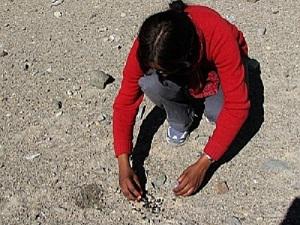Bindu Raghavan
Other projects
Diseases of livestock and wildlife are a major threat to wildlife populations especially in Ladakh, a cold desert characterized by extremes in temperature and seasonal and scarce pasture and water resources. This project is a pilot study to investigate the infectious and parasitic diseases prevalent in the local livestock and wildlife of eastern Ladakh.

Tibetan Wild Ass grazing near Hanle.
Ladakh is a cold, arid region in the rain-shadow of the Himalayas characterized by extreme temperatures and low precipitation, resulting in a short growing season and consequent desert-like vegetation. Thus, pasture and water resources are scarce and seasonal, and human and animal populations are scattered around these. In the eastern part of Ladakh, the nomadic pastoralists depend on livestock for their livelihood and each family may own up to 2000 heads of sheep-goat.

Collecting fecal samples of Tibetan gazelle.
However, the scarce food and water resources and extreme weather make livestock herding a very challenging task. Diseases, especially infectious and parasitic ones, compound the problem by lowering productivity and health. These diseases also affect the health and survival of the unique and mostly threatened wildlife of the region, (including the Tibetan gazelle, Tibetan antelope, Tibetan argali, Wild yak, Tibetan wild ass and Blue sheep) which share the same pastures as livestock. Since these wild fauna already occur as small populations, disease outbreaks and parasitic infestations can pose a major threat to their survival.
In the climate change scenario, new and emerging diseases and parasites will bring in more challenges to wildlife managers and livestock herders. It is, therefore, important to study the infectious and parasitic diseases prevalent among livestock and wildlife in the region and their impact on the same. Baseline information on parasitic diseases and their dynamics in the local wildlife and livestock populations, collected through this project, will help understand their impact on these populations. A pasture use map and disease prevalence database will be developed.
It is hoped that these will be used by a larger project (to be based on results from this one) to investigate infectious diseases in livestock and wildlife and their impact on livestock productivity and local livelihoods. Based on this project, more animals and areas will be sampled for parasitic and infectious diseases of wildlife and livestock and their impact on populations of the same. This will also help local communities to improve livestock production and maintain their livelihoods.